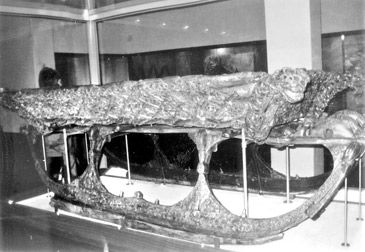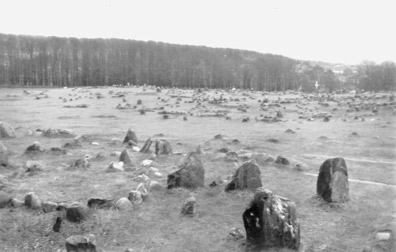Viking civilisation of Scandinavia
Text and pix by W.T.J.S. Kaviratne -Ambalangoda
special correspondent
During the Pre-Christian era the sailors from Scandinavian countries
who crossed the oceans as warriors, traders and explorers were known as
Vikings.
 |
|
Viking period sledge was found among
the items excavated with the Oseberg Ship in Vesfold,
Norway. These items are on display in the Viking Ship
Museum, Oslo, Norway. This sledge was used for travel on
snow and ice. |
Vikings from Denmark, Norway and Sweden during their numerous
expeditions raided, colonised and explored many countries in Europe,
Middle East and North Africa.
They even reached North America, the area now identified as
Newfoundland.
Sacking of monastery of Lindisfarne on the east coast of England in
June 793 A.D. had been marked as the real beginning of the Viking Age.
Availability of more than hundreds of fjords in Norway, Sweden's
network of streams and lakes and Denmark's 500 islands were other
favourable Geographical factors that facilitated the early explorations
of Scandinavians.
Mariners of the time fearing certain disasters beyond the horizon
never willingly left the sight of land. But the Norse skippers explored
the ocean with great determination towards the sunset which other
mariners of the era never ventured.
Thus exploring the oceans, the Vikings colonised the Orkneys, the
Shetlands, the Faroes, the Hebrides, Iceland and Greenland.
At the beginning when Vikings embarked on their first raids they were
known as Scandinavians.
All the Vikings spoke the same language and lived ln isolated farms.
They worshipped the same gods and their bards sang the same songs
praising the old warrior heroes common to all.
Many historians exaggeratedly portrayed Vikings only as raiders and
pirates but they were excellent craftsmen, merchants, explorers,
founders of towns, ship builders and sailors.
Archaeological findings excavated throughout Scandinavian countries
of Denmark, Sweden and Norway and wherever the Vikings found their
settlements reveal the nature of the domestic life of the Vikings. These
archaeological findings related to every aspect of the lives of Vikings
are on display in the museums of Norway, Sweden and Denmark.
Viking religion was pagan and polytheistic. According to Nordic
mythology, the Gods resided at Asgard similar to the Olympus of Greek
mythology. Odin, Thor and Frey were the Gods who reigned over Asgard and
Odin dominated all the other Gods.
Viking literature comprising Eddas and Sagas were transmitted down
the years by word of mouth and this oral tradition existing during the
Viking period was considered as a form of art. Gifted bards of this oral
tradition developed their art became rich and provided their services to
the kings. Vikings continued their explorations for more than three
centuries from 8th to 11th and invaded the neighbouring lands. Later
they acquired their national identities as the Swedish Vikings, the
Danish Vikings and Norwegian Vikings.
 |
|
In 1903, a farmer of Oseberg while he
was digging for gold came across the richest Viking burial
mound. Around 800 A.D. a Viking Queen and her servant were
buried in the Oseberg ship about 80 km South of Oslo. After
excavation in 1904 archaeologists spent over 20 years
conserving and reconstructing, before bringing the Oseberg
ship to Viking Ship Museum in Oslo where it is on display. |
The Swedes sailed eastwards, the Danes towards the west and the
Norwegians were engaged in seizing the unoccupied or thinly populated
lands.
In 982 A.D. the Viking Chief Erik the Red found the land he had
sighted some years ago but found it extremely difficult to approach due
to ice sheets. He named the land he discovered as Greenland.
Next year 25 Viking ships set out for this green country and out of
25 ships only 15 reached Greenland. The Vikings found the town of
Brattalid which is now known as Torugdliarfik.
In Greenland basic necessities were lacking. There was too much iron
but too little timber. The survival of the Vikings in Greenland depended
on the export of fur, skins, walrus teeth and tusks of the Arctic
whales. Around 100 A.D. the population of Greenland was about 3000
peasants living in farms. Just after five centuries this Viking
community disappeared completely out of Greenland.
Ships and the sea played an important part in the life and
imagination of Norsemen.
They played a crucial role in everyday activities. After death, the
ship was supposed to carry the dead man to the afterworld, either as a
funeral pyre as described by Arab traveller Ibn Fadlan. Boats of Viking
age were buried with the dead and securely anchored in heaped burial
mounds or graves whose outlines were boldly marked by stone settings in
the form of ships. To the Viking his ship was not just his means of
transport. It was his home, his way of life, his pilgrim's way something
to love and fear.
During my recent visits to Norway and Denmark, I had the opportunity
to visit the famous Viking Ship Museum in Oslo and several Viking Burial
Mounds and museums in both Norway and Denmark.
Oseberg Ship and Gokstad Ship were remarkable archaeological findings
made in Norway revealing the navigational skills of the Vikings. It is a
miracle that the Gokstad Ship survived which was built around 850 A.D.
This ship was hauled ashore to provide the setting for a Royal Funeral
according to archaeologists. Gokstad Ship was excavated by the President
of the Antiquarian Society in Oslo Nicolay Nicolaysen in 1880.
Near the town of Sandefjord on the western side of Oslo fjord about
three kilometres from the sea the Gokstad ship was lowered into a deep
trench cut into the blue clay underlying the ground surface. A wooden
burial chamber was found constructed inside the Gokstad ship.
A dead King of Viking age was laid on the bed inside. According to
the skeletal remains the King was a powerfully built man in his fifties
who had suffered severely from arthritis or gout.
Round his body the mourners laid out his weapons and assortments of
his personnel possessions such as slaughtered animals numbering 12
horses, 6 dogs, and a peacock.
Gokstad ship is considered as as the most beautiful Viking Ship ever
built. It was built alomst entirely of Oak.
The second Norwegian Ship Burial was excavated at Oseberg Farm in
1904 also revealed the artistic vitality of Viking ship builders.
In August 1903, the owner of the Oseberg Farm came to the University
Museum in Oslo, Norway with some timber remains he had found inside a
large mound on his land.
 |
|
More than 700 graves of the Viking
period are found in Lindholm Hoje, an archaeological site
five kilometres from the City of Alborg in Denmark. This is
one of the greatest Viking burial grounds yet found in
Scandinavia. Graves were marked out with patterns of stones. |
Under the supervision of the Director of Oslo Museum, Professor
Gabriel Gustafsson on May 6, 1904 the excavations started. Inside the
mound, the most beautiful ninth century Viking Ship magnificently
decorated with wood carvings was found.
All its timber had been miraculously preserved by the mound of blue
clay which had been heaped over it. Oseberg ship was built around 800
A.D. and about fifty years earlier than Gokstad ship. Oseberg ship
containd the skeletons of two women, one elderly the other young.
During the Viking Age, in the Kingdom of Agder which was a huge
territory stretching from Larvik to Kristians and a King named Haraldur
Red Beared reigned. His beautiful young daughter Princess Asa was
forcibly abducted by Gudrodur Vestfold. According to saga, it is
believed that the skeleton of the older woman was Princess Asa.
The skeleton of the young woman would have been a handmaid who had
elected or been selected to accompany her mistress to the afterworld.
In Lindholm Hoje which is just five kilometres away from the City of
Alborg in Denmark lies one the most notable ancient monuments that
belonged to the Viking period.
Late in the Viking age the whole of Lindholm Hoje had been covered
with a thick layer of wind-blown sand to a depth of some four metres. A
few stone-set graves had been noticed and excavated late in the 19th
century. Danish archaeologists led by Dr. Thorkild Ramskou of the
National Museum of Denmark did a full scale excavation in 1950. The
majority of the graves in Lindholm Hoje contained cremations and dated
from 500 A.D. onwards. Many of the Viking age graves had been marked out
with patterns of ships using stones. This burial site of Lindholm Hoje
was in use from about 400 A.D. until shortly before 1000 A.D. about 600
years. There are around 700 cremation graves and 41 interment graves at
Lindholm Hoje in Alborg, Denmark.
|

